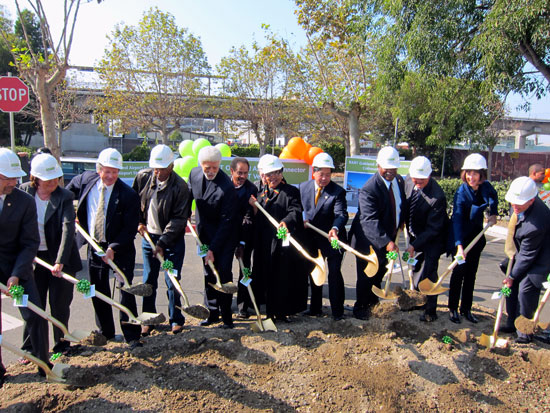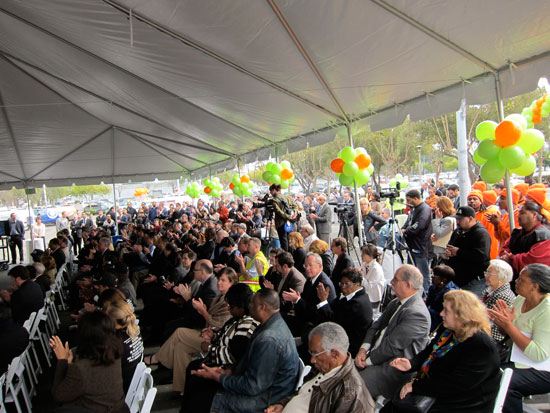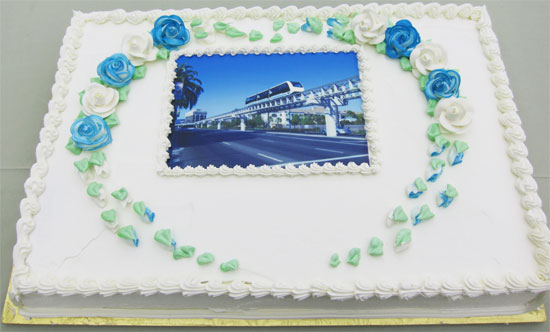BART Holds Groundbreaking Ceremony for the Oakland Airport Connector
9:56 AM PDT on October 21, 2010

After decades of political wrangling, BART is on the verge of building the Oakland Airport Connector (OAC), a $484 million, 3.2 mile automated people mover that will connect the Coliseum BART Station with the Oakland international Airport. BART held a ceremonial groundbreaking yesterday with most of the significant East Bay political establishment, two weeks before the agency gives the Parsons/Flatiron/Doppelmayr team the order to proceed with design and construction.
"There've been many pitfalls throughout this process," said U.S. Representative Barbara Lee, a champion of the OAC and part of the California delegation that helped get further assurances in the eleventh hour from Federal Transit Administrator Peter Rogoff that the project was still going to get nearly $25 million in federal New Starts funding. "I just want you to know that countless Bay Area residents, all of you have come together to make sure this day happened."
Lee led off a round of speeches that went for more than one hour, as each speaker thanked the others on the dais and congratulated everyone for their perseverance. A throng of workers representing the trade unions that hope to work on the project circled the large tent BART erected for the event, roaring with applause every time a speaker mentioned jobs and the project labor agreement with local hiring and zip-code priority guarantees.
The exact number of jobs the project will create has long been a controversy, one that project opponents highlighted to cast aspersions on BART. Even at the groundbreaking, the number was in flux, from several speakers that referenced the 2,500-5,000 direct and indirect jobs over the course of the four years of construction (numbers derived from state and federal jobs creation metrics), to the "several hundred direct jobs" referred to by Oakland Mayor Ron Dellums.
With the recession and unemployment weighing on everyone's mind, Dellums argued the OAC was exactly the kind of project the public should be funding. "One can debate where and how one uses public money," but one can't debate that that public sector spending can have "an enormous impact on the economy," he said.

Dellums had made several entreaties on behalf of BART to the FTA and the California delegation when it seemed the OAC might not get the funding to proceed. "This project today is a shining and magnificent example that the expenditure of public [money] can generate employment, can generate opportunity, can generate business and can strike a mighty blow at the greening of our cities and the greening of our region," he said. "I'm very proud to have played one minor role in making sure that this moment came forward."
The OAC has been one of the most contentious BART extensions in the transit agency's history. Particularly in the past two years, advocates and community groups have used the OAC backdrop as they challenged its funding strategy and the overall civil rights policies of the agency, challenges that led the FTA to declare BART deficient in several areas. Those deficiencies have since been addressed to the FTA's satisfaction, though the resolution of the federal investigation into the agency has not been formally closed.
At the groundbreaking, project proponents were notably relieved, and somewhat bombastic, given that the long debate over the connector appears to be over. BART Board President James Fang milled about before the event started, talking with politicians and reporters. At one point, he mused, "Where's TransForm now?"
Fang was referring to the most visible opponent of the OAC, a transit non-profit that challenged BART's decision to build the people mover and tried unsuccessfully to get the BART Board to consider a bus rapid transit option or other, cheaper alternative. Standing on a curb, Fang exclaimed, "Bring it on!"
Asked to elaborate on the boast, Fang said simply that he wished TransForm were present to "see how happy people are for this project."
BART General Manager Dorothy Dugger expressed relief that the OAC was nearly underway and defended the project against its detractors. "This was a real partnership effort, a coming together of community, of leaders, and the result is a project that will be an investment for generations to come, that will improve the quality of life, improve mobility and help our region continue to grow," she said.
Dugger said the only thing the delay in the project over civil rights and funding had accomplished was to increase construction costs. "I think one of the sad realities is that these kinds of major infrastructure projects take a long time to get to the starting block. It's a truth that goes along with any large project: delay is generally not helpful. Delay only adds cost to the taxpayer."

Dugger was asked by the Contra Costa Times why the event was happening two weeks before the November elections, when the actual groundbreaking and construction of the project won't begin until early next year. James Fang and Carole Ward Allen, the only two BART Board members present at the event, are both facing challengers in their re-election bids in November. "Typically we have a groundbreaking when we start a project and we are starting this project," said Dugger, denying it was related to politics.
"I think this has been such a long process to get to go, such energy and involvement by so many people throughout the community that we didn't want to delay a moment in celebrating the accomplishment," added Dugger.
On November 1st, BART will give the Parsons/Flatiron/Doppelmayr team the notice to proceed, at which point they will have 30 days to deliver their plans for moving forward with construction, according to OAC project manager Tom Dunscombe. Utility relocation will begin shortly thereafter, with construction set to begin in early 2011.
Though BART has yet to secure the full funding for the project, it has enough cash on hand to proceed and Dugger expected to put together the remainder of the financing over the course of the next year or 18 months. BART has applied for a TIFIA loan in excess of $100 million, though it will proceed even if that loan is not awarded. Very few other loan funds have the rates TIFIA does, but Dugger said she was optimistic. She also indicated BART could look to apply for grants or loans from the proposed national infrastructure bank President Barack Obama discussed in a speech delivered over Labor Day.
"We'll look for the most cost effective, most affordable, most flexible loan we can find," she said.

Stay in touch
Sign up for our free newsletter
More from Streetsblog San Francisco
Independent Safety Advocates Beef up the Wiggle
Signs and soft-hit posts installed by advocates make the Wiggle bike route calmer and safer for cyclists and pedestrians




